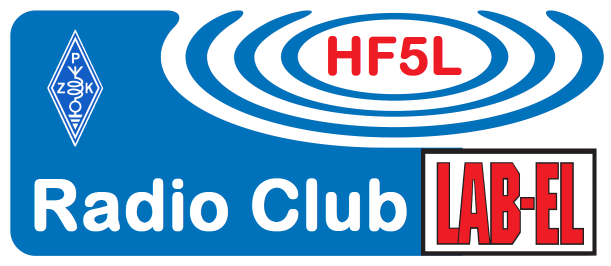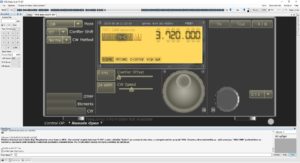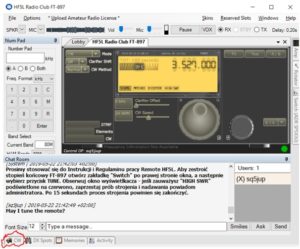The HF5L station has been adapted for remote access via an internet connection. HF5L Remote is initially intended for standard contacts in the 3.5 and 7 MHz bands.
HF5L Remote is currently a 100 W low-power station. It is equipped with a Yaesu FT-897 transceiver with an external AT-897 antenna box, as well as a U5 LINK CAT interface and an Arduino controller for switching on the antenna tuner. W-735 antenna has relatively low efficiency and is narrowband. The station has a 2-minute operating time limit for the transmitter. We anticipate the expansion of the system to work on higher frequencies (antenna switch, rotor).
Currently, users of the installation can be people from the HF5L club members and supporters who have previously read the HF5L Manual and Regulations and have been approved by the HF5L board.
Description of the RCForb console for SSB
• Display – as RX S-Meter; TX indicator when transmitting
• VFO A knob (large)
• VFO B knob (small)
• SIGNAL – always illuminated
• HIGH SWR – when it is lit in red, it indicates that the antenna is not matched. It may light up during tuning through the antenna box.
• Mode (mode, emission)
• Clarifier Shift (RIT)
• CW Method (Farnsworth means increasing the spacing between characters)
• CW – in CW mode, after entering the character it is emitted – do not use
• Clarifier Offset (RIT)
• CW Speed
• TX – transmitting!
• A / B – frequency exchange VFO A and VFO B
• Test – enabling the internal communicator integrated with the system. If the button is illuminated, pressing TX allows “transmitting” without voice transmission to the TX.
• The tab on the right (to be visible click Windows – Switch Control). Name: Switch (ADR SP5IOU). “TUNE” – when pressed, the tuning procedure is started via the external AT-897 antenna box. After 5 seconds, the digits on the display will turn red. During tuning, “HIGH SWR” may be temporarily illuminated in red. After approx. 10 seconds, the tuning process should end and the transmitter is ready for operation at a given frequency.
SSB work
1. Before starting the transmission and making sure that the frequency is free, you should perform tuning with the antenna box by description above.
2. The status “Control OP” is displayed in the lower left corner of the console on a black background. If there is Control OP: Remote Open, you can take control; if Control OP: station call – you can ask a question with open text in Chat Room window or send “Ask” command.
3. Wait for some time if someone will react.
4. During the transmission, check the audio level of the microphone on the oscilloscope strip – it should not be red (clipping).
5. During the transmission, check the “HIGH SWR” indicator – it can not be red!
6. Cases of unusual behavior of the radio and user account should be reported to system administrators.
Description of settings and rules for CW work
1. After logging in, after switching to the CW frequency, tuning the antenna as described above, click on the CW tab in the bottom left corner. The CW options will be displayed.
2. Enter the call from under which you want to call in the field “Your Callsign” (usually HF5L).
3. In the “DX Callsign” field, enter the station that you will be calling for.
4. The remaining fields are filled as required..
5. It is better to mark “Send on Keypress”, then after pressing the key with the chacter will be sent immediately.
6. “Edit Macros” button – here the limit is invention (Save to finish).
Communicator
The system has an integrated communicator (Chat Room), on which a basic written information exchange is possible. In case of doubt, you can always ask “what’s going on in the chat?”. In the chat we can also communicate on the so-called “Priv”. This option appears after clicking the right mouse button on the logged-in user’s sign.
The system also enables voice communication between logged-in users. After pressing the Test button (must remain highlighted) pressing TX causes voice transmission, but the transceiver transmission is not switched on. It is also an excellent tool for testing audio quality, level of control, etc.





Leave a Comment